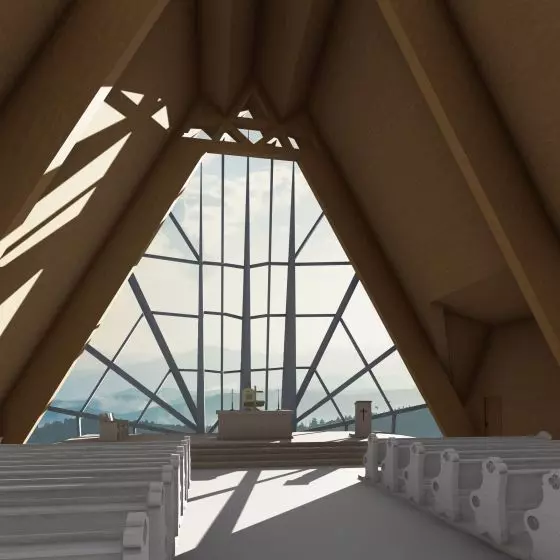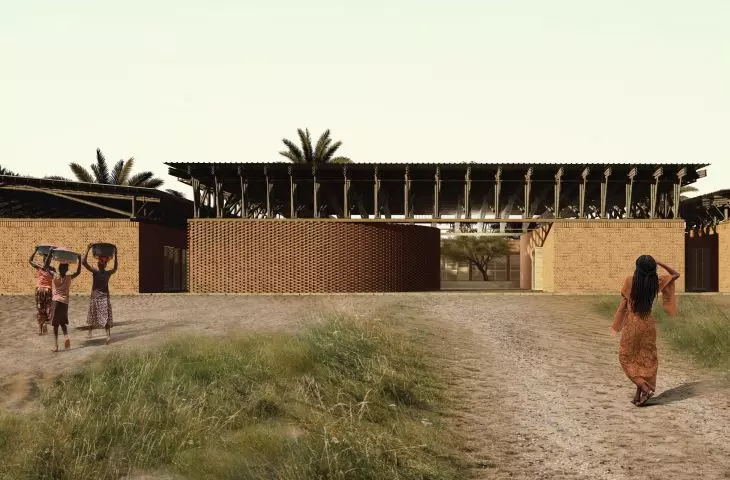Round is a project of a high school in Senegal made by a team of architecture students from Wroclaw University of Technology, consisting of: Justyna Matyska, Aleksandra Tarnowska, Paulina Wrąbel and Wiktoria Zarębska. The concept created as part of the Archstorming platform's international Earth School Competition takes into account local materials, easy construction and the creation of a space conducive to learning and creativity.
Archstorming is an international platform that organizes humanitarian architecture competitions. The platform seeks to prove that architectural designs can go beyond the walls of a building and become a mechanism for making positive changes in society and contributing to the well-being of people.
video showing the competition task
© Archstorming
Given the harsh realities and environment in which many in need live, architecture in such situations must meet basic needs such as shelter, warmth, access to clean water, education, space to build family and community, the organizer's website reads.
Kafountine High School
This year's edition of the Earth School Competition was dedicated to creating a concept for a secondary school in Senegal for about four hundred children. For the design plot, the organizers chose a site located on the northern outskirts of the town of Kafountine. The town, due to the fishing port located there, is currently experiencing rapid population growth. Despite the fact that seventeen thousand people already live there, there is only one high school.
The project by students of the Wroclaw University of Technology made it to the third stage of the competition
© Justyna Matyska, Aleksandra Tarnowska, Paulina Wrąbel, Wiktoria Zarębska
The solution to this problem is the proposed new school - created using local materials including soil, easy to teach construction techniques, and low construction costs. The building was to have ten classrooms, multipurpose space, two offices, bathrooms, a covered courtyard and an open courtyard.
The organizers awarded three grand prizes and two honorable mentions. The grand prize went to a project titled Community Ground by a team consisting of: Donghwan Moon, Jong Hwa Lee, Jee Yeon Han, Byungryoung Lee from the United States.
The classrooms open towards the inner atrium
© Justyna Matyska, Aleksandra Tarnowska, Paulina Wrąbel, Wiktoria Zarębska
Round
The project titled Round by a team of Polish students from Wroclaw University of Technology, consisting of: Justyna Matyska, Aleksandra Tarnowska, Paulina Wrąbel and Wiktoria Zarębska did not receive an award, but was qualified for the third stage of the competition.
Our proposed building is a space created for the Kafountine community. The solutions in the designed building are intended to stimulate creative thinking and a desire to learn. The most important consideration was not only the correct solution of functions or an interesting body, but also the least interference of the building with the surroundings and the possibility of its construction by city residents. Weather conditions, heavy rainfall in the rainy season, droughts, as well as the natural flow of air were factors that significantly defined the final shape of the block. As a result, we obtained a simple form that harmoniously complements the natural surroundings, while creating an architectural object characteristic of the area," the authors explain.
The roof structure facilitates the collection and drainage of rainwater to an underground reservoir
© Justyna Matyska, Aleksandra Tarnowska, Paulina Wrąbel, Wiktoria Zarębska
construction in stages
The students designed the school's functional system on a three-by-three-meter modular grid. In the design, the authors envisioned five phases of construction, so that no matter which phase was completed, the building would appear complete after each one. The first phase of construction includes an administrative section with a multipurpose room and two classrooms, while each subsequent phase expands the premise with two additional rooms.
Due to the location of the projected plot and the prevailing Sudano-Sahelian climate, characterized by a dry season from November to May alternating with a rainy season from June to October, we designed the roof in a shape that facilitates rainwater collection and flow into an underground reservoir at the heart of the establishment, the students add.
Construction is divided into five stages, with each stage expanding the school by two classrooms
© Justyna Matyska, Aleksandra Tarnowska, Paulina Wrąbel, Wiktoria Zarębska
atrium and plant cultivation
The building's façade was designed in brick, and the dominant feature of the mass is a multifunctional hall highlighted by a rounded corner. The classrooms are open towards the inner atrium. The authors placed wooden apertures in the window openings, shading the classrooms while allowing constant air exchange.
An important element of the design was the use of sustainable solutions. The energy needed to light the building and power the pump is generated by photovoltaic panels. The land around the school has been landscaped to grow plants, the income from which would be partly used to maintain the center. In addition, there is a water tower in the garden that collects rainwater needed to irrigate papaya, banana, passion fruit and mangoes.
The open nature of the building invites users
© Justyna Matyska, Aleksandra Tarnowska, Paulina Wrąbel, Wiktoria Zarębska
Read also about the Windbreak Shelter temporary shelter project, for which students of Wroclaw University of Technology - Natalia Junger, Natalia Walkiewicz, Aleksandra Wasilenko, Angelika Zysiak - received first prize in the Asylum competition organized by the UNI platform.






























